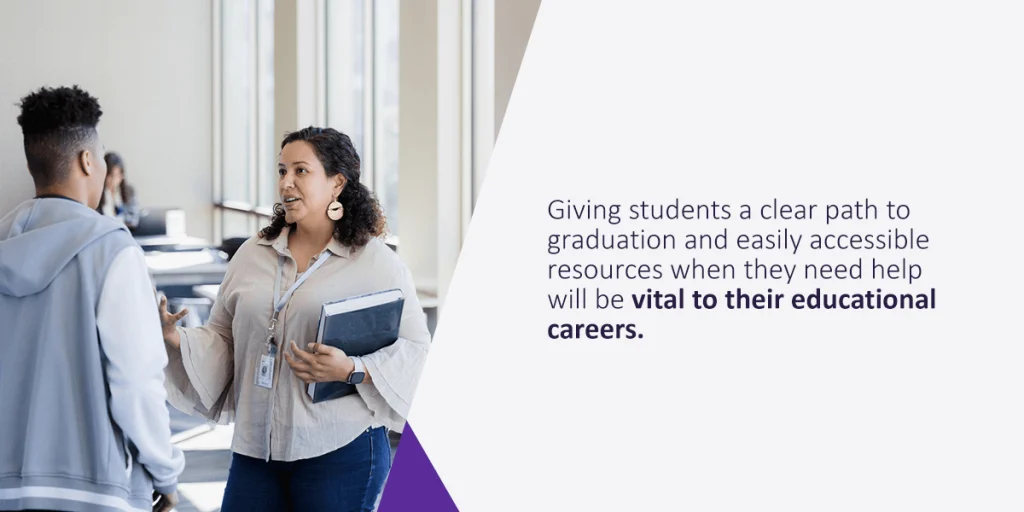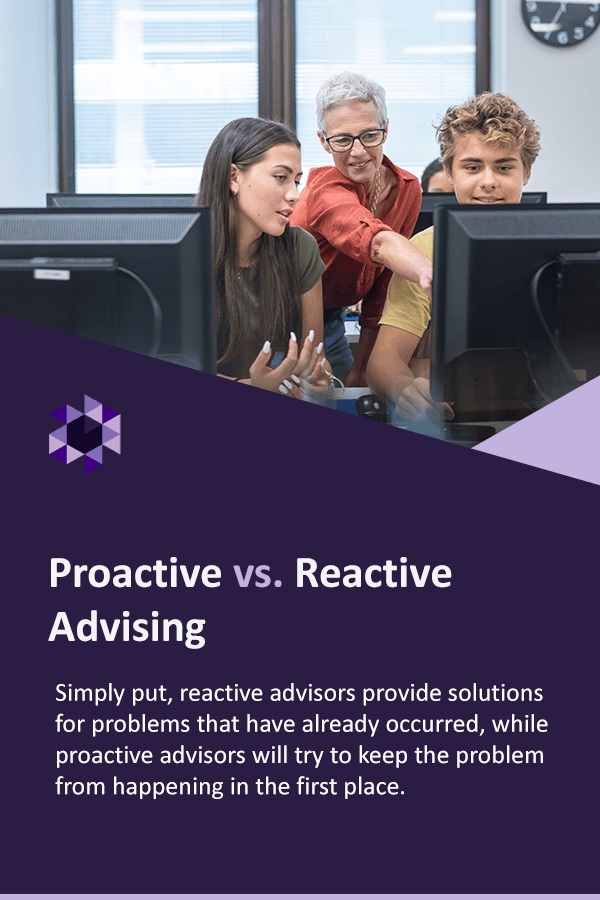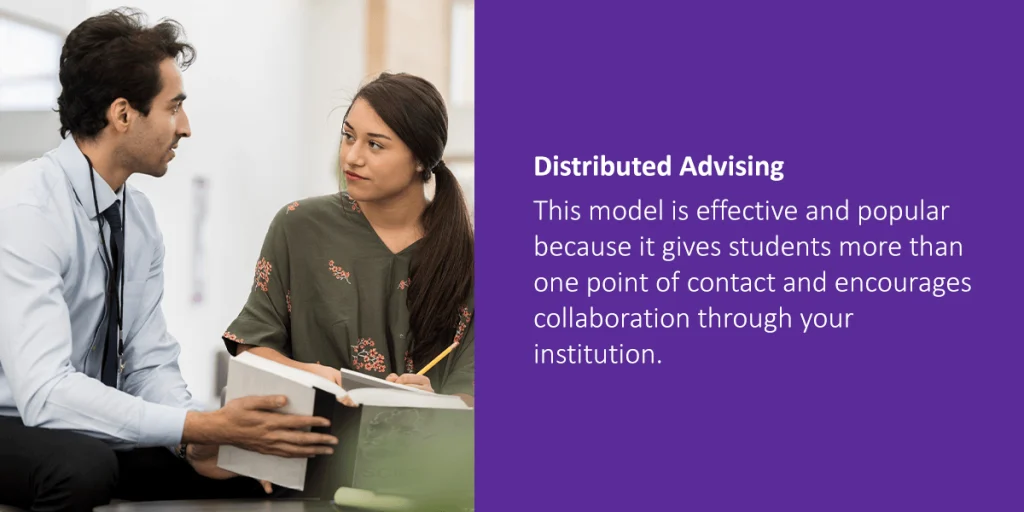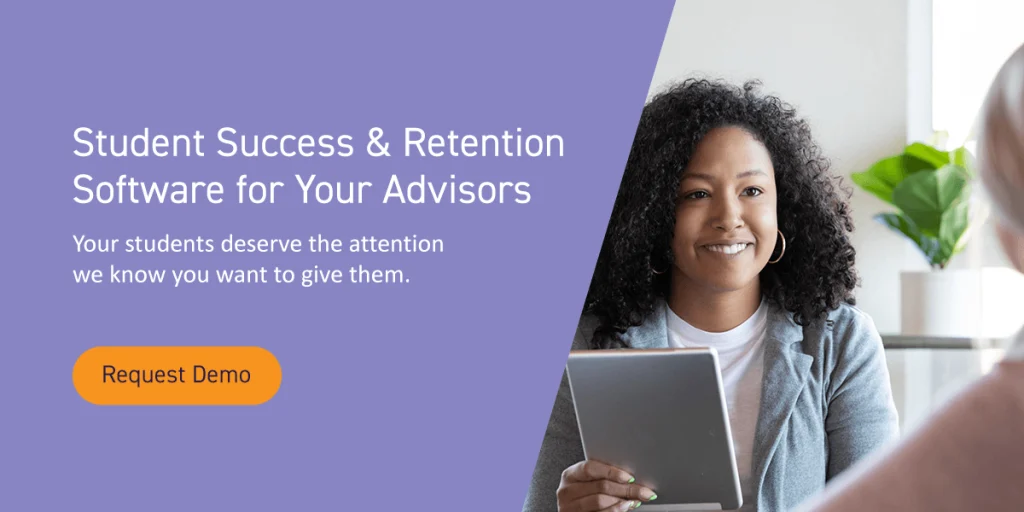



Although many post-secondary institutions have a student success center in one form or another, many more don’t have a well-structured staff or guidance plans, which impedes student experiences. Proactive advising greatly benefits your students, including increasing their retention, encouraging them to stay engaged, and giving them a guiding hand when they need assistance.
Along with supporting your students, you may see your institution reaching initiatives and setting new goals sooner than expected as your students become more engaged and finish their programs due to their academic advising guidance.
Developing proactive advising techniques will encourage your students and allow them to seamlessly find or request the information they need to finish their programs and graduate on time. Our guide to proactive advising techniques will explain the importance of this advising method, list the common advising models you may want to use, and discuss how to implement them in your institution.
Proactive advising is student intervention that you direct and structure to intervene with students as soon as an academic difficulty arises. This technique actively encourages students to seek help rather than internalize their struggles and allow the situation to worsen.
Proactive advising involves:
The purpose of academic advising is to connect with students and give them actionable solutions that guide them through their program. A proactive academic advisor does far more than hand out schedules and call students into their office when their grades are slipping. These faculty members take on the role of an instructor in an informal setting.
Advisors provide students with success strategies, help them define their academic purpose, and encourage them to make decisions and problem solve. Advisors can also become counselors or mentors for students by offering advice, listening to struggles, guiding students through procedures and policies, or referring them to additional services if they need more support.
College is a challenging transition for many students. It’s common for students to have questions about their studies, schedules, and paths to graduation. Students struggling academically may graduate later than expected, take too many or too few classes, or contemplate dropping out.
Giving students a clear path to graduation and easily accessible resources when they need help will be vital to their educational careers. This path is especially important for those with an undecided major or at-risk students who don’t see the value in their education.
Some students may be under the impression that any class that fits their schedule will fulfill a requirement or not realize that specific courses are only offered during particular parts of the year. By missing enrollment dates and taking non-beneficial classes, they may accidentally fall behind their peers.
Academic advisors will guide students toward the courses, internships, and programs that fit their needs and ignite their interests, so they can stay on top of their studies and feel rewarded for their accomplishments.

A reactive advisor differs from a proactive one because they are less involved in student processes. Reactive advisors will wait for students to ask hard-hitting questions rather than provide them with solutions before there’s an issue. While proactive advisors actively seek opportunities to speak with students, reactive advisors wait for students to come to them.
Many higher education institutions will have an office for students to receive additional aid but don’t take steps to show students their benefits. Although students may know where the advising office is or understand that your institution has one, they may be unaware of what advisors can do for them and how beneficial advising can be if they rely on themselves to seek all information.
Simply put, reactive advisors provide solutions for problems that have already occurred, while proactive advisors will try to keep the problem from happening in the first place. Proactive advisors keep students on track and save effort and time in the long run because rather than catching students up to speed, they avoid seeing them fall behind in the first place.

Proactive advising is a great way to get connected with your students while encouraging them to stay on track, seek new challenges, and enhance their desire to learn. This form of advising has many benefits that make it crucial for your institution to implement.
Benefits of proactive advising include:
Academic advising and student success go hand-in-hand because proactive advising increases student retention, engages students with their materials, and promotes a lifelong learning habit. Because advising gives students a defined structure, they can follow the right path from the beginning of their educational journey to its end. With the right resources, students will interact with their instructors more often, participate more in collaborative learning, show more effort, and challenge themselves academically.
It’s important to note that students who don’t feel connected with their advisor or have a negative experience may not see the benefit of asking for aid. They may not view the experience as being valuable and avoid reaching out. It is vital that your advisors are proactive and approachable. When advisors take control to schedule appointments and initiate student contact, students are more likely to follow through with their actions and receive the additional support they need.
Following a proactive advising model is the first step you can take to providing your students with valuable success resources. If your institution is experiencing problems with academic advising, there are a few different ways you can improve.
The following are four primary models that many post-secondary education institutions follow:
If your institution uses faculty advising, you will be dedicating a faculty member, usually from the student’s academic department, to be each student’s advisor. Choosing professors and other staff that your students will regularly see as academic advisors can be very beneficial for students because they will have multiple opportunities to speak with them and form a deeper connection. If students take classes with their advisor, they may feel more inclined to visit during office hours, stay after class, or schedule another meeting time.
However, you should be aware of your faculty’s current responsibilities. For example, if a professor works another job, leads campus organizations, or otherwise cannot provide many office hours, they may not be a good fit for your students. Although their availability does not speak to their ability to advise, their assigned students may become frustrated at the lack of availability, and your staff member may face an overwhelming workload.
With a distributed advising structure, you assign your students to a department advisor, but you also dedicate a central administrative unit to support the department advisors. The administrative team provides the department advisors with training and other educational resources while providing student assistance with tasks such as degree audits and transfer course evaluations.
This model is effective and popular because it gives students more than one point of contact and encourages collaboration through your institution. Your department advisors can receive any additional resources they need to give your students a holistic advising experience, and your students can feel confident that they have another person to talk to if they happen to feel disconnected from their department advisor.

Self-contained advising occurs in one centralized location with professional advising staff. This form of advising can be very beneficial for students and staff because all students will know where to locate the resource, and your staff will be less likely to feel overwhelmed because their primary job focus will be on advising students.
If you already have success resources like a writing center, tutoring, or internship and career offices, consider finding office space for your academic advisors in the same location. This will provide students with one centralized location to find all the additional help they may need. Additionally, instructors can advertise the center without being concerned about whether they’re providing the correct information for students outside of their department.
However, one thing to note is that some students may feel less connected to the advisors with this model. Whereas students will encounter their professors and other faculty daily, academic advisors in one location may only see students during meetings. Your advisors may need to initiate more contact with your students to motivate them to seek assistance.
A split advising structure is a popular combination of faculty and distributed advising models. With this means of advising, your faculty advises their departments, but there is also an advising center that becomes responsible for specific subsets of students. These subsets could include freshman, transfer students, students on academic probation, those with undecided majors, or otherwise potentially at-risk students who need additional help navigating their career path and finding their professional voices.
The four advising models we have listed are not the only ones available, but they are the most popular among two- and four-year institutions. Whether you are debating between our list or a few other structures that you’ve found, you’ll need to consider whether your institution can realistically implement that model.
Things to consider before choosing a proactive advising model include:
Watermark provides data measurement, collection, and analysis through our unique software that encourages you to conduct institutional research, plan intervention strategies, and recognize where your students are excelling or struggling. People are at our center and we want to provide easy solutions to deliver your students the support they need.
You can use our software to aid your proactive advisors in finding valuable information about each of your students. Our Student Success & Engagement program will enable you to sort through data quickly, track trends, and be notified of students who may be at risk. You can get ahead of academic challenges by identifying those who may need assistance and promptly finding solutions to the struggles they’re facing.
You can also use our Faculty Success software to minimize the work your staff needs to complete every day, giving them even more time to dedicate to your students or free up time for themselves. You can also use this software to track faculty accomplishments and progress, so you can take an active role in ensuring your staff provides everything your students need.
Request a demo of Watermark Student Success & Engagement or Faculty Success and develop your proactive advisory models as soon as possible. Your students deserve the attention we know you want to give them. Encourage them to finish their studies and find value in their education while seamlessly tracking their progress.






























































































































































































































































































































































































